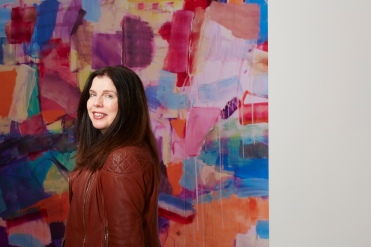
Diana Copperwhite
Back in February, I had the pleasure to sit down with Diana Copperwhite in her home in Dublin to discuss her art practice. Diana’s enthusiasm for paint as a medium is so evident from talking to her that you come away invigorated and enthused about paint and what can be accomplished in the medium. My hope is this interview does that conversation justice.
How would you describe the act of painting?
I think of the physicality of painting and allowing paint to just be what it is. I am fascinated by what it can do rather than the overly illusionistic aspect of it.
What really hits me when I’m painting is that whatever object I’m looking at is really abstract. They’re just shapes, lines, contours and spaces. We look at things in a figurative way because our brains are wired to recognise certain arrangements within our history of spatial recognition. I’m interested in the potential for [that recognition] to break down – the way information breaks downs when you look at the space between things. The physicality of it; the push and pull of your brain recognising something. All the while, it’s just paint. It’s quite an exciting space.

Trip Switch. (2015), oil on canvas, 175.3x235cm, courtesy of 532 Thomas Jaeckel Gallery, New York, photo by Gillian Buckley
When I was giving a talk in NCAD [The National College of Art and Design] about my work, I spoke about the point within the painting where I create these layers and I’m responding to the mark that I made before – these oblique kinds of spaces where anything can happen. I’ve let the painting take its own direction but there’s a point now where I have to do something deliberate. The colour bars and those kinds of detached shapes that seem to float; they’re very deliberate. From there, I’m very sure about what I’m doing next. It’s like a different part of my brain is making the decision. It’s the pull between these two ways of working that makes the painting and makes me feel like they work for me because otherwise, the work would be too beholden to chance. That’s not to say that there isn’t any deliberation in gestures of chance but it’s a different kind of fast and instinctual deliberation, whereas this is more methodical.
You’ve described the process as creating chaos, then organising it.
In a lot of my paintings, I have a deliberate mid-tone range with a lot of greys, and the paintings can go very muddy for a while. They have to go through a process for a brief time in their construction where they look awful, but that’s great because it means I have to rescue them! I know what I’m doing throughout. The bright colours can stand out when the painting is constructed over a period of time. If I gave in all the time, nothing would happen. A lot of it comes from that chaos. I think it’s a disaster but then I manage to turn it around. [The process] is often about adapting to what is happening on the canvas. I’m not rigidly stuck in the idea that, “This is the way it is and it’s going to stay like this for the whole painting.” Painting creates a tension between chaos and order. For me, exploring that dynamic in painting is kind of the point.

Counter Culture, (2015), oil on canvas, 235cm x 175.3c, courtesy of 532 Thomas Jaeckel Gallery, New York, photo by Gillian Buckley
Let’s discuss a day in the studio for you.
I’m more comfortable just reacting to information around me. Overthinking never works for me. So, when I get into the studio I just let myself go into a sort of free fall. Recently, I have been responding to a photograph I found of [French painter and printmaker Pierre] Bonnard’s wife with the reflection of her in the mirror and another mirror reflected back. I liked the image, and it has inspired some work. But the next five paintings could be inspired by something else. It could be just something that’s in my head.
I believe that you must have a relationship with the painting. Usually, I will work on a painting over a couple of weeks. I have to stay in touch with it, stick with it, and not break from it to the point where I lose the connection. If I start painting and I don’t stick with it, when I go back, I can’t see it in the same way. There are exceptions, like if you are visually tired and you try to continue, you can destroy it. What I sometimes do is turn it around for two or three weeks and when I return, I have a different relationship to the canvas. Visual tiredness can be even more destructive than physical tiredness. Visual tiredness is like burnout.
I paint multiple works at the same time because you can put too much pressure on a painting when you focus on one only. You’re not able to allow it to fail. You can’t relax and take risks when everything is pinned on one thing. The more you make, the more failure but also, the more chance for a few of them to flow. I remember when I first started painting years ago, the paintings used to feel a bit leaden to me until I managed to loosen up and relax. I’d go, “OK. If I don’t let go, nothing will ever happen.” I think they were black and white initially when the change happened. Maybe there was just more material use and fluidity but they seemed to take on a life of their own. They had a degree of unpredictability. I started to use a lot of white, which allowed the other colours to flow and merge. I have always found colour fascinating.
Science is another point of interest in your work. Where did that come from?
There is a lot of science in my family. My brother is a physicist. I find it interesting myself as an artist because it frees me from what I think is concrete reality. It gives me the freedom to think that anything is possible and my relationship to an object in front of me is not exactly how it appears. Then in a way, [the abstract paintings] feel more real than a traditional painting of a coffee cup. It feels more real to acknowledge that, when I see an object, there is a time delay – something in the middle that we can’t see.
I was talking to one of my students who taught physics at Maynooth University about the electromagnetic spectrum and infrared. When I was 16, I loved [German Renaissance painter] Hans Holbein’s painting of Sir Thomas More because the arm of his velvet jacket is painted as if it were an infrared image, but it was 1527 and infrared wasn’t discovered until 1800, so he couldn’t have known. It’s a 21st-century eye interpreting a 16th-century painting with new information. What people will know in the future and how that knowledge informs their interpretation of reality… For example, you can see heat radiation in glowing coal but when the wavelength cools and shifts into the infrared region, you can’t see it anymore. That doesn’t mean it’s not there. Certain animals that see different spectrums can still see it, and that’s fascinating. I’m here in a specific time and space looking at things within my limitations. I always wonder about what else can you not see? There is a little bit of mysticism there but I like it when science and mysticism meet in the middle, and create a healthy space for art. Then you can really start to wonder and feel free to create visuals that actually have some grounding in reality because you’re exploring what you are observing. When you can no longer see something but it’s still there; what does that mean? I also find all of that stuff about collapsing stars and infinite darkness fascinating.
You showed a large digital print in your duo exhibition with Ciara Barker for the Galway International Arts Festival at the 126 Gallery last year. Could you explain the decision behind that?
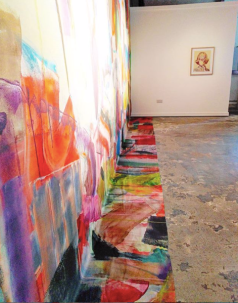
installation shot, Galway International Arts Festival, 126 Gallery
When GIAF asked me to do something for the festival, I had already been working on some large paintings for TULCA [Festival of Visual Arts]. So, I thought I would do something different. I had previously created wall paintings for the likes of the Highlanes Municipal Art Gallery and the Centre Culturel Irlandais in Paris.
A change in my practice came about from Double Vision, a show I had worked on for the dlr-Lexlcon in Dún Laoghaire. When preparing for Double Vision, I was informed that I wouldn’t be able to paint on the walls. I was actually kind of relieved at the time because I wanted to start working with different materials. So, I came up with this idea of using a fabric print. It was an experiment. I asked the LexIcon to send out an email to people in the area for 30 seconds of phone footage of anything. The idea was to look through another person’s eyes. I started to draw a pattern based on what I was looking at over the duration of the video, and let it evolve and overlap with the original drawing. While I was looking at the extremely varied footage, I was also looking at what I had drawn before. My instinct was to compose it subconsciously.
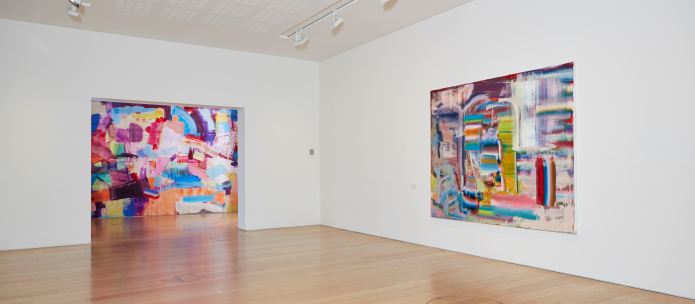
Double Vision installation shot at the DLR Lexicon, Dun Laoghaire, 2018
Before that, I had an exhibition called Driven by Distraction for the RHA [Royal Hibernian Academy]. I created a large wall painting in response to our interpretation of media and how that relates to memory. I walked around the RHA with a camera, taking little videos of different spaces, then I combined all of them to create one flat space. My work for the Galway Arts Festival was an evolution of the work I had done in the LeIicon and the RHA. The colour was more subjective – more me – but the pattern came from footage acquired from Galway locals. I worked with a company in Donegal to create the final prints.
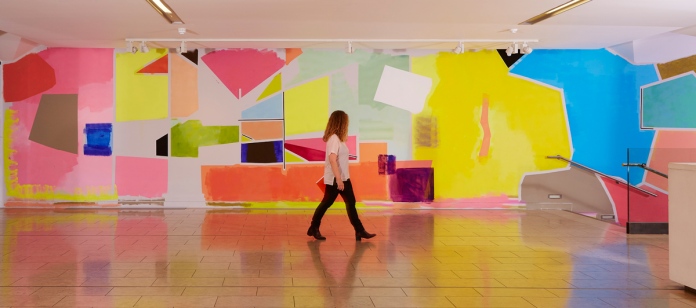
“Driven by Distraction” at the RHA Gallery, 2016, Acrylic paint and videotape on the wall, 10 foot x 30 foot
I think I’ll continue doing stuff like that because I’m able to show different sides of my practice through it. The paintings have a personal dimension and a physical dynamic but the prints are different. I like that I can present the more ordered part of me in making prints. if I only made wall prints, I would get bored. Sometimes the paintings can be very overwhelming but I need both. I can’t do one without the other. They allow me to think in different ways.
Conversation is a term you have used in the past to describe your work. What does it mean to you?
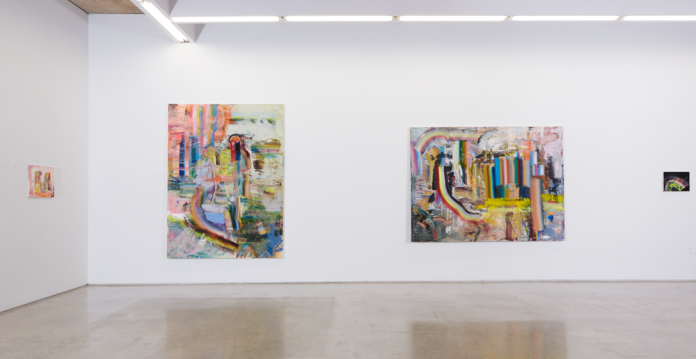
example installation shot
When I place the works in an exhibition, I organise them in such a way that they can breathe and not be on top of each other. Sometimes a really small painting kind of works near a large painting. It makes you aware of just how large the large one is, and vice versa. They talk to each other. [These decisions]It makes the viewer move within the space – looking closely at the big one, moving back to take in the whole painting and then automatically focusing in on the smaller one. There are so many different things happening in the large paintings; it’s like a sentence, and then you have this little black painting beside them like a full stop or a comma.
You can find out more about Diana Copperwhite’s work through her website link below
http://www.dianacopperwhite.net/
thank you Meadhbh McNutt for your work editing
